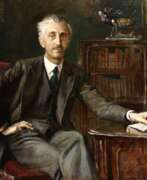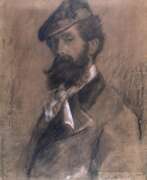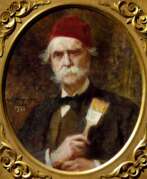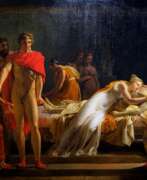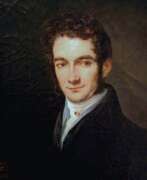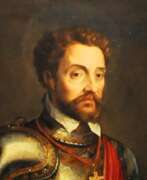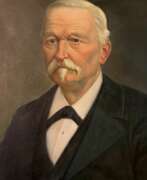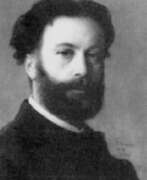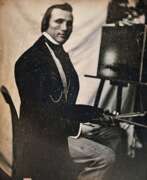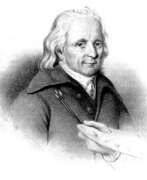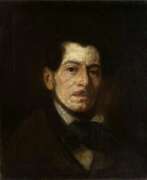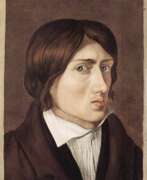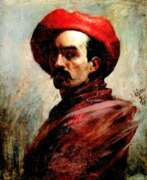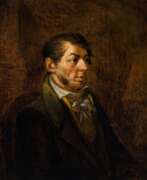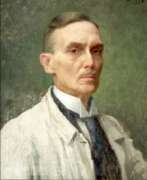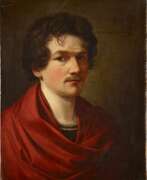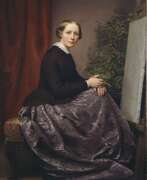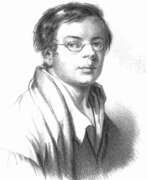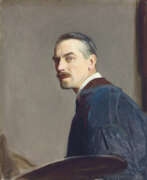Self-portrait Romanticism


George Barret the Younger was a British painter, master watercolorist and landscape painter.
He was the son of the Irish painter George Barret the Elder (1730-1784) and learned painting from his father. He exhibited at the Royal Academy from 1800 and was one of the first and active members of the Society of Watercolor Painters, which was formed with his own encouragement in 1804. His early works were mainly topographical landscapes in a style similar to his father's watercolors. Later he switched to more romantic compositions with imaginary landscapes.
In 1840, George Barret published The Theory and Practice of Watercolor Painting.


Karl Pavlovich Bryullov (Russian: Карл Па́влович Брюлло́в), a distinguished Russian artist, emerged as a pivotal figure in the world of 19th-century art, blending Western European Romanticism with his Russian heritage to create works that continue to captivate audiences today. His mastery in painting and architecture set him apart, making him a celebrated figure not just in Russia, but across Europe.
Bryullov's acclaim primarily stems from his remarkable ability to infuse his paintings with vibrant life and emotion, a testament to his profound understanding of human expression and the dramatic interplay of light and shadow. His most famous work, "The Last Day of Pompeii," exemplifies this skill, showcasing an epic narrative filled with vivid detail and emotional depth. This masterpiece, which is housed in the State Russian Museum in St. Petersburg, has garnered international praise for its innovative approach to historical painting, merging accuracy with dramatic storytelling.
Beyond "The Last Day of Pompeii," Bryullov's portfolio includes a range of subjects, from majestic portraits to serene landscapes, each bearing his signature blend of realism and romanticism. His works are featured in prestigious galleries worldwide, serving as a testament to his enduring influence on the art world. For collectors and experts in art and antiques, Bryullov's oeuvre offers a fascinating glimpse into the evolution of 19th-century European painting, marked by a unique intersection of culture, art, and history.
For those intrigued by the enduring legacy of Karl Pavlovich Bryullov and his contributions to painting and sculpture, we invite you to sign up for updates. Our subscription service provides exclusive alerts on new product sales and auction events related to this illustrious artist, ensuring that enthusiasts and collectors alike stay informed about opportunities to engage with Bryullov's remarkable works.
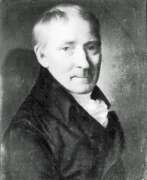

Daniel Caffé was a distinguished German pastel painter of portraits. Known for his meticulous craftsmanship and the emotive depth of his portraiture, Caffé initially embarked on a career in architectural decoration before his talents led him to Dresden to become a portrait artist.
Daniel Caffé's journey into the world of fine arts was marked by his study at the Dresden Academy of Fine Arts under the guidance of significant figures like Casanova and the influence of neoclassical artist Anton Raphael Mengs. His mastery of pastel made him a favored portraitist among the nobility and notable figures of his time, including Russian patrons like Prince Beloselski and Admiral Fyodor Grigoryevich Orloff.
His works, celebrated for their detailed and expressive nature, capture the essence of his subjects with striking realism and emotional depth. Among his notable works are portraits of prominent individuals such as Johann George Tromlitz and Karl August von Hardenberg, which not only exemplify his skill but also his contribution to the documentation of his era's influential figures.
Daniel Caffé's legacy as a pastel painter is preserved in various art collections and continues to be admired for its historical significance and artistic merit. He passed away on January 16, 1815, in Leipzig, leaving behind a body of work that continues to be studied and revered in the art community.
For collectors and experts in art and antiques, Daniel Caffé's portraits offer a glimpse into the refined pastel techniques and cultural narratives of the late 18th to early 19th century. His works remain a significant part of German art history, celebrated for their contribution to the development of portrait painting.
To explore more about Daniel Caffé’s life and works, consider signing up for updates on exhibitions and auctions where his art is featured. This will provide opportunities to engage more deeply with the legacy of this notable artist.
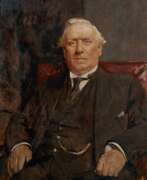

André Edmond Alfred Cluysenaar was a Belgian painter. He was especially known for portraits and female figures. He was member of the Cluysenaar family, descendant from a long line of architects who originated in Aachen. He received his first art lessons from his father, then studied with François-Joseph Navez. Initially, he worked as a sculptor, but devoted himself entirely to painting after 1902. He was firmly grounded in the romantic style at first; producing still lifes and genre scenes, but later turned to impressionism and painted mostly female figures, often semi-nude. He also executed monumental ceiling paintings for the City Hall in Saint-Gilles. During World War I, he lived in London where he established a reputation painting portraits of notable people, including the Royal Family, which were done in a more commercial style using Alfred Stevens as a model. Most of these portraits may be seen in the National Gallery.
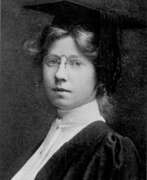

Imogen Cunningham was an American photographer known for her botanical photography, nudes, and industrial landscapes. Cunningham was a member of the California-based Group f/64, known for its dedication to the sharp-focus rendition of simple subjects.
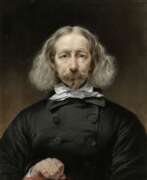

Jean Augustin Daiwaille was a Dutch portrait painter and lithographer. He studied under Adriaan de Lelie. He was director of the Rijksakademie from 1820 to 1826. After that time, he resided at Rotterdam, where he was very successful in painting portraits. He was an early exponent of lithography during the 1820s, overseeing the installation of a lithographic press at the new Koninklijke Academie, and instructing the students on the use of the technique. He established his own lithographic business in 1826, producing reproductions of his own paintings, and collaborating with other artists such as Barend Cornelis Koekkoek to make copies of their work.
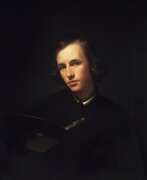

George Henry Hall was an American still-life and landscape artist. He studied art in Düsseldorf and Paris and he worked and lived in New York City, the Catskills of New York and in Europe. His works are in museum collections in the United States and Europe. Over the course of his career he sold 1,659 paintings.


Orest Adamovich Kiprensky (Russian: Орест Адамович Кипренский) emerged as a masterful Russian portraitist in the Age of Romanticism. His journey from an illegitimate serf background to a celebrated artist is a testament to his extraordinary talent and determination. Kiprensky's early exposure to art at the St. Petersburg Academy of Arts paved the way for his signature style, marked by emotional depth and technical brilliance.
Orest Kiprensky's works resonate with the spirit of Romanticism, capturing the essence of his subjects with remarkable sensitivity and nuance. His portrait of Alexander Pushkin is among his most famous, celebrated for its vivid portrayal of the poet's character. Kiprensky's life was as dramatic and varied as his art, with significant periods spent in Italy, where he immersed himself in the local culture and art scene, eventually marrying and converting to Roman Catholicism.
His legacy is enshrined in numerous galleries, where his portraits continue to captivate audiences with their expressive intensity and elegance. Orest Kiprensky's ability to capture the soul of his subjects on canvas ensures his enduring status as a pivotal figure in Russian Romantic art.
For those fascinated by Orest Kiprensky's life and work and keen on updates related to his art, including exhibitions and sales, subscribing to relevant updates can provide valuable insights into the world of this distinguished portraitist.


Johan Thomas Lundbye was a Danish painter and graphic artist known for his landscapes of his native country and depictions of animals.
He studied at the Royal Danish Academy of Fine Arts and responded to the call to develop national art by depicting Denmark's characteristic landscapes, monuments and historical sites, as well as its inhabitants.
Lundby's views of mounds, cliffs and coastlines were appreciated - he became one of the national Romantic artists of his generation.


Matthias Maris was a Dutch painter, etcher and lithographer. He initially belonged to the Hague School, like his two brothers, Jacob and Willem, but his later works deviated more and more from that school into a unique style influenced by the Pre-Raphaelites. Most of the paintings by M. Maris are in museums and private collections in Great Britain and the USA. A great admirer of the artist's talent was Vincent van Gogh.


Alfred Jacob Miller was an American artist best known for his paintings of trappers and Native Americans in the fur trade of the western United States. He also painted numerous portraits and genre paintings in and around Baltimore during the mid-nineteenth century.
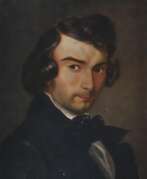

Apollon Nikolaevich Mokritsky (Russian: Аполлон Николаевич Мокрицкий) was a Ukrainian-Russian painter and art educator, known for his contributions to the 19th-century art scene. Born in 1810 in Pyryatyn, Ukraine, Mokritsky became an influential figure in Russian academic art, specializing in portrait and historical painting.
Mokritsky's work is celebrated for its detailed realism and emotional depth. His portraits often capture the essence of his subjects, showcasing his skill in rendering lifelike expressions and intricate details. One of his most notable works is the portrait of the renowned Russian poet, Taras Shevchenko, which exemplifies his ability to combine technical precision with profound sensitivity.
In addition to his painting, Mokritsky played a significant role as an educator. He taught at the Moscow School of Painting, Sculpture and Architecture, where he mentored many young artists who would go on to shape Russian art. His influence extended beyond his own works, helping to cultivate a new generation of artists.
Today, Mokritsky's paintings can be found in various museums and galleries, including the Tretyakov Gallery in Moscow. His contributions to art and education continue to be recognized and celebrated by art collectors and historians alike.
Sign up for updates to learn more about new product sales and auction events related to Apollon Nikolaevich Mokritsky.


Aleksander Orłowski (Russian: Александр Осипович Орловский), a renowned Polish painter and sketch artist, was born on March 9, 1777, in Warsaw, within the Polish-Lithuanian Commonwealth. His journey into the arts began under challenging circumstances; he was the son of a tavern-keeper and his family was not wealthy. His early promise in art was nurtured by noble patron Izabela Czartoryska, who financed his initial education under the guidance of artist Jan Piotr Norblin.
Orłowski's artistic journey intersected with his military service during the Kościuszko Uprising, a major revolt against Imperial Russia and Prussia in 1794. This period of conflict significantly influenced his later works, which often depicted military scenes and the daily life of soldiers. After the partitions of Poland, Orłowski moved to Saint Petersburg in 1802, where he became a seminal figure in the development of lithography in the Russian Empire.
His oeuvre includes a wide array of subjects, from battle scenes to cultural depictions of everyday life in both Poland and Russia. Notable works such as "Battle Scene" and "Cossack Fighting Off A Tiger" showcase his skill in capturing dynamic movement and drama. His works are preserved in esteemed institutions such as The Russian Museum and The Tretyakov Gallery, highlighting their historical and artistic value.
Orłowski's impact extended beyond the canvas; he was also mentioned in literary works by notable authors like Adam Mickiewicz and Alexander Pushkin, which underscores his cultural significance in the 19th century.
For collectors and experts in art and antiques, Aleksander Orłowski's works represent a crucial segment of Eastern European art history. To stay informed about new discoveries or auction events related to his works, consider subscribing for updates. This subscription ensures you receive timely information tailored to your interests, directly relating to new sales and significant events around Orłowski's art.
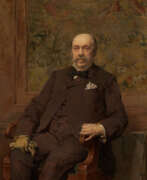

Jean-François Portaels was a distinguished Belgian painter. He is celebrated for his mastery in Orientalist art, genre scenes, and portraits. His education under the tutelage of François-Joseph Navez at the Academy of Brussels shaped his early artistic direction.
Portaels' career was marked by significant academic roles, including his tenure as the director of the Academy of Fine Arts in Ghent and later the Académie Royale des Beaux-Arts in Brussels. His influence extended beyond Belgium through his extensive travels across Europe and North Africa, where he absorbed and later depicted the exotic and vibrant cultures of Morocco, Algeria, Egypt, and Lebanon.
His works, such as "The Oriental Beauty" and "Portrait of Aouicha," are celebrated for their detailed depiction of Eastern subjects, characterized by elaborate costumes and serene expressions. These paintings not only display his technical skill but also his ability to convey the subtle nuances of different cultures.
Portaels was also a key figure in monumental art in Belgium, contributing to national identity through his historical and biblical scenes painted for many Belgian churches. His legacy is preserved in his contributions to the Belgian Orientalist school and his role in shaping the next generation of Belgian artists.
For collectors and experts in art and antiques, Jean-François Portaels' works offer a unique glimpse into the 19th-century Orientalist movement. To stay informed about exhibitions and sales featuring Portaels' art, sign up for our updates and ensure you don't miss out on acquiring a piece of this influential artist's legacy.


Carl Friedrich Sandhaas was a German painter and draftsman. Sandhaas preferred to work as a landscape and portrait painter; he also worked as an illustrator of literary and mythological works. As a draftsman and watercolorist, he is one of the most important representatives of late romanticism in Baden.
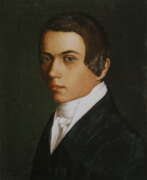

Grigory Vasilyevich Soroka, née Vasiliev (Russian: Григорий Васильевич Сорока) was a Russian painter, known for his mastery in realistic portraits and landscapes that beautifully captured the essence of 19th-century Russia. His artistic journey began under the guidance of his teacher, Alexei Venetsianov, a prominent figure in the Russian art scene. Soroka’s works are remarkable for their attention to detail, vivid portrayal of peasant life, and sensitive handling of light and shadow, distinguishing him from his contemporaries.
His most notable works include "The Peasant Girls Gathering Brushwood" and "Self-Portrait," both exemplifying his skill in using light to express depth and emotion. These paintings are celebrated for their historical and cultural significance, providing a window into the rural life of Russia during that period. Despite his untimely and tragic end, Soroka’s contributions to Russian art have not been forgotten, with several of his works displayed in prestigious galleries, including the Russian Museum in St. Petersburg.
For art collectors and experts, Soroka’s pieces represent a valuable connection to Russian heritage and the realism movement. If you wish to stay informed about upcoming sales and auction events featuring works by Grigory Vasilyevich Soroka, consider signing up for updates. This subscription will ensure you are promptly alerted to new opportunities to acquire pieces by this distinguished artist.
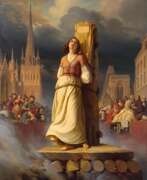

Anton Hermann Stilke, a German painter associated with the Düsseldorf School of Painting, is renowned for his depictions of Joan of Arc's life. Originally interested in agriculture, he pursued art and studied under Carl Wilhelm Kolbe and Peter von Cornelius. Stilke worked on various projects in Düsseldorf and Munich, including frescoes in the Munich Hofgarten. He also decorated Stolzenfels Castle's Great Hall with murals depicting the "Six Knightly Virtues." Stilke became a professor at the Berlin Academy. His wife, Hermine Peipers, was an accomplished watercolorist.
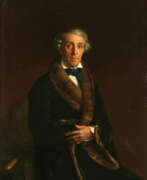

Fyodor Petrovich Tolstoy (Russian: Фёдор Петрович Толстой) was a Russian sculptor, painter, and medallist, renowned for his contributions to Russian classicism and romanticism. Born in Saint Petersburg in 1783, he became a prominent figure in the Russian art world. As a vice-president of the Imperial Academy of Arts, Tolstoy produced significant works, including medallions commemorating the Patriotic War of 1812.
Tolstoy's artistic style is characterized by its meticulous detail and classical influence. His works, such as the intricate medallions and bas-reliefs, often depict historical and allegorical scenes. These pieces are celebrated for their technical precision and emotional depth, embodying the spirit of the era.
Many of Tolstoy's creations are housed in prestigious collections, including the State Hermitage Museum and the State Tretyakov Gallery. His legacy continues to inspire and influence Russian art and culture, making him a significant figure in the history of Russian fine arts.
Subscribe for updates on new product sales and auction events related to Fyodor Petrovich Tolstoy. Stay informed about the latest opportunities to acquire pieces of his artistic legacy.
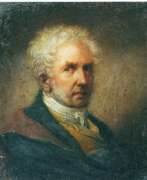

Salvatore Tonci was an Italian painter, musician, singer, and poet, renowned for his multifaceted artistic talents and his life largely spent in Russia. Born in January 1756 in Rome, Tonci moved to Russia in 1797, where he significantly contributed to the cultural scenes of St. Petersburg and Moscow until his death in December 1844. He was instrumental in the founding of the Architectural School in Moscow and is celebrated for his portrait paintings, which capture prominent figures of his time in a style that combines Italian finesse with Russian sensibilities.
Throughout his career, Tonci produced a series of notable works, including portraits of Russian Emperor Paul I and the poet Gavrila Derzhavin. His work is characterized by its historical depth and artistic mastery, reflecting the social and political landscapes of 18th and 19th century Russia. His contributions were not limited to painting; he also engaged in poetry and played a vital role in the artistic community as an educator, supervising drawing classes at the Moscow School of Painting, Sculpture and Architecture for over two decades.
For those interested in exploring the works of Salvatore Tonci or learning more about his contributions to art and culture, his paintings and other artistic expressions provide a fascinating glimpse into the rich cultural interchange between Italy and Russia during his lifetime. To stay updated on new discoveries and auction events related to Salvatore Tonci, you can sign up for updates, ensuring you don't miss out on any valuable insights or opportunities related to this remarkable artist.


Vasily Andreevich Tropinin (Russian: Василий Андреевич Тропинин) was a Russian Romantic painter, whose journey from serfdom to artistic freedom is as captivating as his art. Born in 1776, Vasily Tropinin spent a significant part of his life as a serf, only gaining freedom at the age of 47. His talent in painting, particularly in portraying intimate, personal, and "disheveled" portraits, earned him the nickname "a robe portraitist" among Muscovites.
Vasily Tropinin's works are celebrated for their deep analysis of the Russian national character and their reflection of the social types of his era. Notable works include "The Lace Maker," "Portrait of Alexander Pushkin," and portraits of everyday people, capturing the essence of Russian life with authenticity and emotional depth.
His contributions to Russian art did not go unnoticed, as he was awarded the title of "appointed academician" and later elected an Academician, reflecting his status as a respected artist of his time. Vasily Tropinin's legacy lives on, with more than 3,000 portraits credited to his name, and the Tropinin Museum in Moscow dedicated to his and his contemporaries' works.
For collectors and experts in art and antiques, Tropinin's paintings offer a unique window into 19th-century Russian life and culture. To stay informed about updates related to Vasily Andreevich Tropinin, including sales and auction events, consider signing up for updates, ensuring you remain connected to the rich heritage of Russian art.
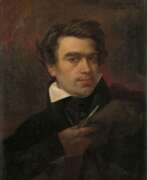

Pieter (Pierre) van Hanselaere was a Belgian painter in the neoclassical style, who specialized in portraits and religious and historical scenes. In his early days he specialized in portraiture and achieved a high level of technical perfection. Due to the Napoleonic wars he was not able to leave for Italy until 1816; when he did, he first stayed in Rome and painted portraits of some high-ranking officials, before moving to Naples and achieving success there as well, becoming the painter for the royal court.
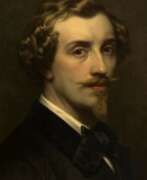

Joseph Henri François Van Lerius was a Belgian painter in the Romantic-Historical style. Van Lerius painted mythological and biblical scenes as well as portraits and genre pictures. Much of his work is didactic in nature. Perhaps his best-known work is "Lady Godiva", which was shown at the Antwerp Triennial Salon in 1870. Many of his works (especially "Lady Godiva" and "Cinderella") have been widely reproduced.
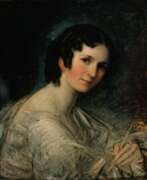

Maria Elektrine von Freyberg was a German painter. Trained by her father, Johann Baptist Stuntz, a renowned landscape painter, Maria quickly demonstrated remarkable artistic talent. Her extensive travels through France and Italy greatly influenced her work, especially her stay in Rome, which enriched her painting style.
Maria Elektrine's art is celebrated for its delicate touch and emotional depth, particularly in historical scenes and portraiture. Some of her notable works include "The Holy Family," "The Birth of St. John," and "A Boy Playing the Flute." These pieces are distinguished not only by their technical excellence but also by their tender and evocative portrayals of their subjects.
Her works are held in high esteem and can be found in various prestigious collections, such as the Munich Gallery, the Leuchtenberg Gallery, and even as far as the Hermitage in St. Petersburg. This widespread recognition underscores her contributions to the 19th-century art scene, particularly within the German Romantic movement.
For those deeply invested in the world of art and antiques, Maria Elektrine von Freyberg's works offer a rich exploration of German romanticism. Her paintings are a testament to her skill and a window into the cultural and historical milieu of her time.
If you are an enthusiast or a collector keen on early 19th-century art, ensure you stay informed about updates related to Maria Elektrine von Freyberg's works. Sign up now to receive notifications on new discoveries, auction events, and sales concerning her masterpieces. Join us in preserving and appreciating the legacy of one of Germany's illustrious painters.


Johann Karl Ferdinand von Kügelgen was a German landscape and history painter, known for his work as a Russian court painter and his contributions to both the Imperial Academy of Arts in St. Petersburg and the Prussian Academy of Arts in Berlin. Born on February 6, 1772, in Bacharach am Rhein, Kügelgen's artistic journey took him across Europe, where he honed his skills in various cities including Frankfurt, Würzburg, and Rome.
Kügelgen's paintings are celebrated for their transparency and ethereal color palette, often reflecting the natural landscapes he was deeply inspired by. His notable works include over 200 landscapes and depictions of ancient monuments, particularly from his travels to Crimea under the commission of Tsar Alexander I. These works are highly valued for their historical and artistic significance, capturing the essence of the regions he explored.
During his career, Kügelgen faced many challenges, including financial difficulties and the turmoil of the Napoleonic Wars, which forced him and his family to flee to Wolsk. Despite these hardships, he continued to produce art and teach, leaving a lasting legacy through his works and his influence on future generations, including his son Konstantin von Kügelgen, who also became a renowned landscape painter.
If you are an art collector or enthusiast, sign up for updates on upcoming sales and auction events related to Johann Karl Ferdinand von Kügelgen. Stay informed about new opportunities to acquire pieces of his remarkable legacy.
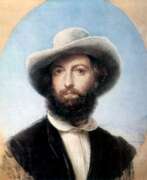

Otto Friedrich Theodor Möller (Russian: Фёдор Антонович Моллер), a Russian academic painter of Baltic-German descent, was renowned for his detailed and expressive portraits, figure paintings, and genre scenes. Born in 1812 in Kronstadt, Saint Petersburg, Möller was deeply influenced by his mentor, Karl Briullov, at the Imperial Academy of Fine Arts. His journey as an artist was marked by a successful tenure in Italy, where he embraced the vibrant local culture and further honed his skills, particularly in portraying everyday Italian life and historical narratives .
Möller's artworks are celebrated for their clarity of composition and expressive color palette, traits he mastered under Briullov's guidance. His notable works, like the portrait of Nikolai Gogol, are admired for their lifelike representation and emotional depth. These paintings not only showcase his technical skill but also his ability to capture the subtle nuances of his subjects' personalities.
Möller's contributions to Russian art extend beyond his paintings. He was a professor and a significant figure at the Imperial Society for the Encouragement of the Arts, dedicating much of his later years to teaching and supporting fellow artists. His works are held in high esteem and continue to be featured in major Russian museums, including the Tretyakov Gallery and the Russian Museum.
For collectors and enthusiasts wishing to stay updated on exhibitions and auction events featuring Otto Friedrich Theodor Möller's works, signing up for newsletters and alerts from relevant art institutions can be highly beneficial. This ensures that you remain informed about opportunities to view or purchase his esteemed works.
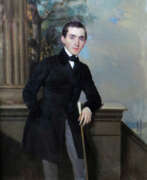

Pyotr Zakharovich Zakharov-Chechenets (Russian: Пётр Захарович Захаров-Чеченец), a Russian painter of Chechen origin, was a notable artistic figure in the 19th century. Born in 1816, he was adopted by Major-General Pyotr Yermolov and showed early talent in painting, which led him to the Imperial Academy of Arts in Saint Petersburg. Despite facing significant obstacles, including racial discrimination that barred him from receiving a scholarship to study in Italy, Zakharov excelled at the Academy and graduated in 1835 with a diploma of Free Artist.
Zakharov became a prominent portraitist, attracting the patronage of significant figures, including the favorite daughter of Nicholas I, Grand Duchess Maria Nikolayevna. His works, known for their expression and depth, include notable portraits such as that of Aleksey Petrovich Yermolov in 1842, which earned him membership in the Academy of Arts. His pieces were highly regarded and are held in prestigious collections, including the Tretyakov Gallery and the Russian Museum.
Tragically, Zakharov's life was cut short by tuberculosis, passing away in 1846 shortly after his marriage. His legacy, however, continues to be celebrated, with his art significantly featured in collections and studies concerning Russian artists of his era. His work not only highlights his artistic skill but also serves as a testament to his resilience against the societal challenges of his time.
For those interested in the profound work and enduring influence of Pyotr Zakharov-Chechenets, updates on exhibitions and sales can be subscribed to, ensuring enthusiasts and collectors stay informed on available works and new discoveries related to this distinguished artist.


